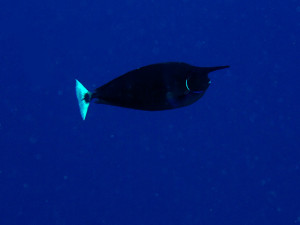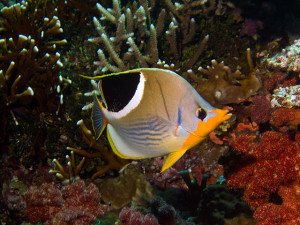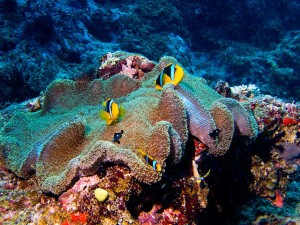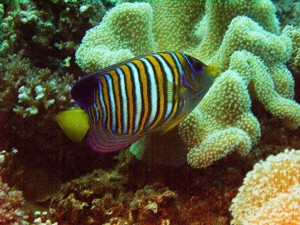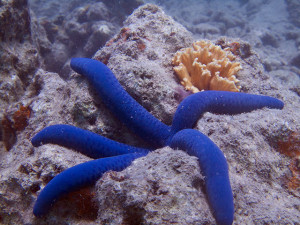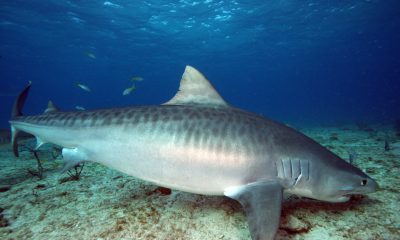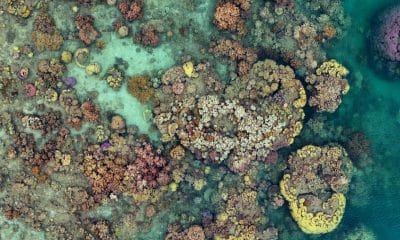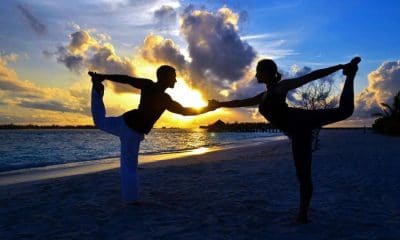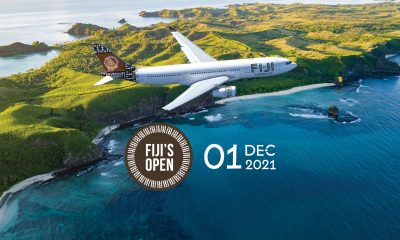Travel Stories
Diving Fiji from Wananavu Beach Resort

The mere mention of Fiji brings to mind beauty above and below water – tropical islands scented with fragrant blossoms and the sound of rustling palm fronds. Divers have seen photographs and video, heard stories from friends of spectacular soft corals and brilliantly colored fish. As with most divers, Fiji was high on our “must-dive list”. It is a long trip however, that carries you across the International Date Line. Under most circumstances we would have opted for a liveaboard in order to maximize diving and then spent a few days on land. In this particular case though, we could not extend our trip and therefore elected to do a land-based resort. We took the recommendation for Wananavu Beach Resort and found it to be an utterly delightful experience.
If one wishes to discuss practical matters first, Wananavu is located on Viti Levu, Fiji’s main island, approximately 2.5 hours drive north from the Nadi airport. The distance allows you to see the small villages and much of the varied terrain as you drive slowly behind trailers bearing sugarcane or perhaps stop to allow livestock to be herded across the two-lane road. It became apparent that the idea of getting a car and exploring the countryside on our own in that part of the island would require both a four-wheel drive vehicle and a definite sense of adventure. The resort has a number of excursions that guests can take to local sites. We were not able to avail ourselves because of the timing of the dives, but if you have non-divers along or a “down day”, that would be the chance to check out the famous “Cannibal King’s” village.
As for the diving, managers Chris and Victoria Liles operate the in-house Dive Wananavu, a fully functioning dive operation with rental equipment, nitrox, and PADI instruction available. The gear storage area by the lagoon is nicely arranged and it is only steps to the boat dock and the two custom-built dive boats, Nami (Japanese for Wave) and the smaller Nami Lailai. Chris and Victoria’s goal is a simple one and that is, “To provide a land-based operation, with the feel of a liveaboard.”
From the moment you turn your gear over to one of the dive staff, you know you are in the hands of people who want to share their passion for diving. While the boats are rated for 18 and 8 people respectively, they try to keep them at a maximum of 16 divers (more commonly 14 though) and 6 divers respectively. The boats can make the run to the Vatu-I-Ra passage in approximately an hour and there are numerous other sites closer to the resort. As you plunge into the water of whichever site is selected, you quickly understand why this area is referred to as “the soft coral capital of the world”. On one particular site, “Wheatfield”, the mass of golden-colored coral swaying does indeed look like its namesake. There were so many clownfish of all sizes darting in and out that it was not possible to count them all. And as popular as little “Nemos” are, the spectacular colors of the angel and butterfly fish catch your eye with each vivid flash that passes you. Not that my husband, the photographer, didn’t appreciate them, but he was busy capturing pipe fish as often as he could and beautiful nudibranchs. Black-tip and white-tip sharks tended not to linger once we entered the water, usually gliding away within a few minutes.
Aside from seeing banner fish, unicorn fish, and a wide variety of angel and butterfly fish, there were many species that we never did identify nor capture in photo. One was particularly intriguing and another diver told us that we’d seen a dart fish as we described the peculiar shape. In addition to fabulous marine life and underwater topography, most of the sites were simple to navigate as they were pinnacles in one shape or the other and visibility ranged from 70-100+ feet. The pinnacles allowed for multi-level diving with plenty to see during the safety stop. Current was mild to moderate, only strong on the first day at one site.
We had both been keeping a very hectic schedule for months and made the decision to dive each morning and snorkel in the afternoon after a leisurely al fresco or beachside lunch. Shore diving is also available although the visibility at the resort itself is only approximately 20-25 feet. Despite that, there are lovely blue starfish and other marine life as well as easy access for getting in and out of the water. Snorkeling happened to work better for us even though several guests enjoyed the shore diving (Okay, the snorkeling part may have had to do with the leisurely lunch including cold beer).
As wonderful as the diving is, the resort is designed for relaxation and was exactly the kind of place that we needed. There are no telephones or televisions in the rooms and the internet is extremely limited. The idea of coming to Wananavu is to unplug and unwind.
The buildings are arranged in a tiered fashion with the lobby, gift shop, restaurant and bar at the top of the property to give a panoramic view across the water. The pool, complete with man-made waterfall, is the next level down with a path that winds to the far side to take you to the small spa area. When you book a bure (room), you can opt for garden, partial ocean view, or beachside. Native hardwoods are used throughout and with a small balcony off our partial ocean view room, we would sit at night and watch glittering stars as we listened to the slap of waves against the sand below us. The beach sand is groomed daily and the sunrises and sunsets are lovely. The birdlife is plentiful among the familiar tropical offerings of hibiscus, bougainvillea, and other flowering shrubs that I wasn’t familiar with.
It does take a few strolls along the foliaged-lined paths to become properly oriented and at the very lowest level to the left is the lagoon with the dive shop, boats, another beach area, and beach café that is open for part of the day. There was in fact, a black seahorse that had been resident in the lagoon for a while, but it had disappeared a day or two before we arrived.
Fijians are known for their hospitality and warmth and that was reflected among the entire staff. The food plan at the resort includes a large continental breakfast as well as cook to order if you wish. The two course lunch menu provides sandwiches, soups, entrees and desserts and it is expanded to three courses for dinner. Alcoholic beverages are an additional cost and there is a full bar service. There is a buffet every few nights and one night is usually devoted to a “Fijian Lovo” which features traditional cooking and later a “Meke” – story-telling through dance. A local trio provides music each afternoon and evening though and the “kava bowl” is available if you wish to try this regional beverage made from the roots of the kava plants. I confess that we did not choose to partake, although we most assuredly enjoyed the local beer, rum, and of course Australian and New Zealand wines.
If you plan to attend DEMA in Orlando in November 2013, you can stop by the Dive Wananavu booth and meet the Liles in person. Or you can log onto http://www.DiveWananavuFiji.com and access their Facebook Page at http://www.Facebook.com/DiveWananavuFiji.com for more information and blog posts.
Blogs
Alonissos: The complete diving destination (Part 1)

In June we were incredibly fortunate to be invited to dive in Alonissos, a small Greek Island in the Sporades island chain located in the North Aegean Sea. While I have long been a big fan of the Greek Islands as a great holiday destination, I had not had the opportunity to do any diving on previous visits and Mike and I were extremely excited to see what Alonissos had to offer both above and below the surface!

The Sporades are easily accessible via the airport in Skiathos (the first island in the chain), which is served by Jet2 flights from all major UK airports from May through October. Numerous ferries and charter boats make island hopping from Skiathos Town a breeze. After an hour boat ride, the picturesque port of Patitiri was a wonderful introduction to Alonissos, where we were met by our gracious hosts Kostas of Albedo Travel and Dias of Alonissos Triton Dive Center. Mike and I were delighted to be staying at the Paradise Hotel, aptly named for its stunning views over the sea and great location for walking to the waterfront.

Alonissos is beautifully situated in the National Marine Park of Alonissos and the Northern Sporades, the largest marine protected area in Europe. The surrounding seas offer fabulous marine life, including incredibly rare species such as the Mediterranean monk seal. They boast deep walls covered in gorgonians and sponges, stunning topography with caverns, swimthroughs and pinnacles, and the first accessible ancient shipwreck from 500BC!

In locations where historical sites have been reported, the waters are largely restricted, but with collaboration between government, underwater archeologists and dive centres, incredible underwater museums are being created for a truly unique diving experience. Alonissos is home to the first of these, the Ancient Shipwreck of Peristera Accessible Underwater Archeological Site. The chance to dive into history (along with reports of healthy reef life and amazing underwater topography) meant Mike and I were keen to get in the water.

Our introduction to the diving around Alonissos was at the Agios Georgios Pinnacles, in the channel between Alonissos and Skopelos. This fantastic site was named “The Chimney,’ and proved to have a huge amount to see. We got to a decent depth here (over 25m), and marvelled at a colourful reef wall with a wonderful swim through whose rocky walls were absolutely covered with life. As well as brilliant topography there was no shortage of macro life here. We saw numerous nudibranchs, five different species in total. The second dive at Mourtias reef nearby was a shallower dive along a nice wall with lots of crevices. Several moray eels and grouper called this site home. We enjoyed looking in the crevices for lobster and smaller benthic life, such as cup corals and tunicates.

Our itinerary allowed us two dives a day with afternoons left to explore the island with our hire car and evenings to enjoy the famous Greek hospitality. This proved to be a lovely mix of in-water and land based diversions.

The next days diving to the Gorgonian Gardens and Triton’s Cave was to be even better! These two stunning sites are nothing short of fabulous. The Gorgonian Gardens was a deep wall near to the Agios Georgios islands. The ever-present currents in this deep channel meant that the sea life was amazing … the namesake Gorgonian sea fans dotted the wall at a depth of 30 to 50 meters, getting ever larger the deeper we went. Above 30m was by no means less beautiful, with sponges, corals, scorpionfish, moray eels and some rare and colourful nudibranchs.

The second shallower dive of the day was to Triton’s Cave or the Cavern of Skopelos, on the east side of that island. The spectacular rock formations had wild striations both above and below the water making a truly epic topography. The cavern entrance was at 14m, and big enough for a buddy pair, winding up to 6m and passing two beautiful windows out into the blue. Emerging from the cavern, the light at the shallower depths and the incredible rock formations made for a fantastic gentle swimming safety stop and we all surfaced by the boat with massive grins.

Check out our next blog :Alonissos: The complete diving destination (Part 2)” to hear about our amazing dive on the 2500 year old Peristera Wreck!
Thanks to:
Alonissos Triton Dive Center https://bestdivingingreece.com/
Albedo Travel https://alonissosholidays.com/activities/
Paradise Hotel https://paradise-hotel.gr/
Alonissos Municipality https://alonissos.gr/en/
Blogs
Mamma Mia! Diving Skopelos (Part 2)

Our second days dive itinerary was to the famous Christoforos wreck! This is arguably the best dive in Skopelos and though only open to divers with deep diving experience, this 83m long wreck is well worth the visit.
The Christoforos sits in 43 meters of water with the deck at 32 to 35 meters. A 30m dive can give an impressive view of the wreck, though such a large wreck needs a few dives to truly do it justice. Given its ideal location just a 2 minute boat ride from the dive centre dock it is an excellent first dive of the day. The sheltered site is also diveable in all but the absolute worst weather so although deep, the water is usually clear with little to no current making it a very pleasant dive. The site is superb for technical diving and a great training site for the Tec 40 and 45 programs, offered by Skopelos Dive Center.

The Christoforos wreck was originally a collier ship built in 1950 at Grangemouth shipyard under the name “Thomas Hardie”. In 1976 she joined the Greek merchant fleet as “Christoforos”. On the 2nd of October 1983 the Christoforos was carrying 2600 tonnes of cement from Volos to Piraeus Port. During the voyage the weather turned, resulting in the ship developing a 7 degree list, whereby she changed course for safe anchorage at Panormos, Skopelos. The ship reached Panormos at 16:00 with a list of 17 degrees and water ingress to No. 1 hull. Though attempts were made to right the vessel, the crew were ordered to abandon ship at 22:00. The captain, lieutenant and the quartermaster remained to try and save the ship, but had to abandon the attempt themselves and the Christoforos finally sank at 05:30 on 3rd October 1983. She now sits upright in 43 meters of water less than 200m from shore in Panormos.

Diving has only been allowed here since 2018, so the wreck is very well preserved and a real treat to dive. Permission to dive here was granted by the authorities after lots of incredibly hard work by the Skopelos Dive Center staff. Having a fantastic wreck in such an amazing location and in excellent condition is a real privilege.

Of all the sites in Skopelos this was the site Mike and I were most keen to experience. Having kitted up and zipped across the bay to the mooring, we left the surface and followed the descent line until the wreck emerged spectacularly from the blue at 15m. She is a big and beautiful wreck, sitting as though calmly continuing her journey along the seabed. With most of her original features still intact there were points of interest everywhere, including the anchors, winches, ships telegraphs, the wheel and RDF antenna.

We found that aquatic life had colonised the ship, with schools of fish, electric blue nudibranchs, a large moray eel and the resident scorpionfish lurking inside the bridge. The Christoforos was truly a stunning wreck and despite maximising our time at depth we eventually had to say our goodbyes and begin the slow and steady return to the surface.

After a superb morning dive we had the afternoon to do a little sightseeing of the island, with a trip to the church of Agios Ioannis Kastri made famous by the blockbuster movie “Mamma Mia!”. Mike and I spent a happy afternoon pootling around in our little hire car before meeting up with Lina from Skopelos Dive Center. An underwater archeologist as well as a dive professional, Lina had offered to show us a rather special attraction, the Christoforos shipwreck Digital Spot public information and awareness centre.

A fantastic initiative made possible from the collaboration of the government and hard work of the staff at Skopelos Dive Center is the “Digital Spot” in Agnontas port. This information center has a number of displays on the history of the Christoforos wreck, the process by which the wreck was allowed to be opened to the public for diving tourism, other sites of historical interest in the area, a video of the wreck and the best bit, a virtual reality dry dive experience! The beauty of the VR system is that non diving members of the family can see what you have seen on the wreck, or you can see areas that you may not have explored during the dive due to time or depth limitations. It was a truly immersive experience and a great addition to the dive itself.

After a wonderful day we celebrated our last evening on the island with an exquisite meal in Skopelos Town with fabulous views over the town and bay, washed down with the excellent local wine. The lamb with lemon and potatoes was a meal which I could happily eat every day for the rest of my life!

Skopelos is an island that truly has it all. The diving is excellent, the landscape is beautiful with plenty of non diving activities, the locals friendly and the food and drink superb. Given how accessible it is as a holiday destination it has avoided becoming overcrowded and even in peak season offers a fun yet relaxing atmosphere. We highly recommend giving Skopelos a visit. We will certainly be back again!
Thanks to:
Municipality of Skopelos (https://skopelos.com/)
Skopelos Dive Center (https://sporadesdiving.gr/)
Ionia Hotel (https://www.ioniahotel.gr/en)
Dolphin of Skopelos (https://dolphinofskopelos.com/)
Ta Kymata restaurant (@takymata)
The Muses restaurant (https://www.facebook.com/TheMussesMousses/)
Aktaiov resturant (https://skopelos.com/listings/aktaion-taverna/)
-

 Blogs2 months ago
Blogs2 months agoDiving With… Nico, Ocean Earth Travels, Indonesia
-

 News1 month ago
News1 month agoMurex Bangka Announce New Oceanfront Cottages & Beachfront Dining
-

 Blogs2 months ago
Blogs2 months agoA new idea in freediving from RAID
-

 Marine Life & Conservation1 month ago
Marine Life & Conservation1 month agoIceland issue millionaire whale hunter a licence to murder 128 vulnerable fin whales
-

 Marine Life & Conservation2 months ago
Marine Life & Conservation2 months agoThe Shark Trust Great Shark Snapshot is back
-

 News3 months ago
News3 months agoCharting New Waters; NovoScuba Goes Global with the Launch of their Revolutionary Dive Training Agency!
-

 Gear News1 month ago
Gear News1 month agoNew Suunto Ocean – a dive computer and GPS sports watch in one for adventures below and above the surface
-

 Marine Life & Conservation Blogs2 months ago
Marine Life & Conservation Blogs2 months agoBook Review: Plankton


